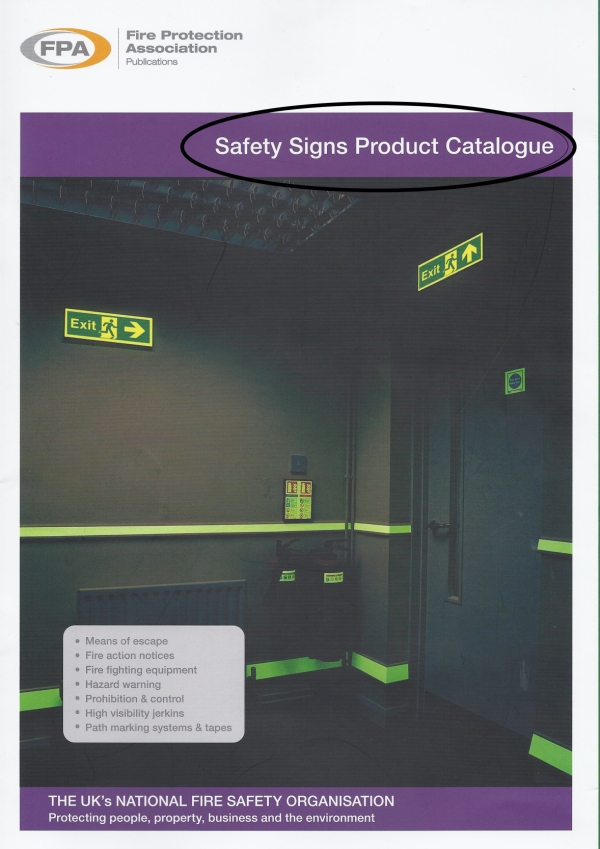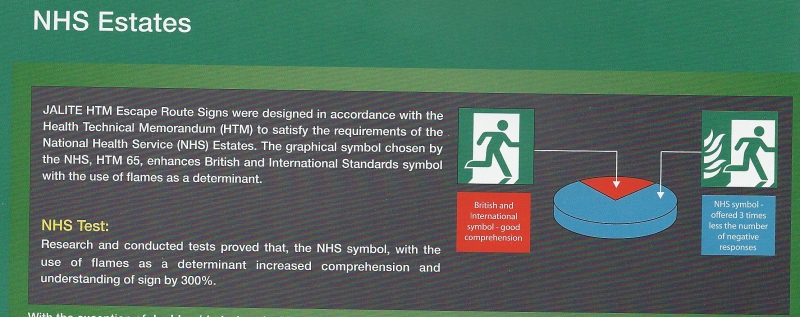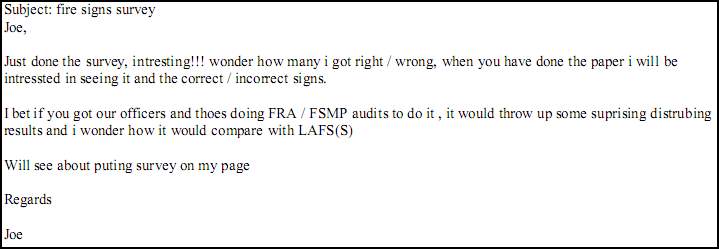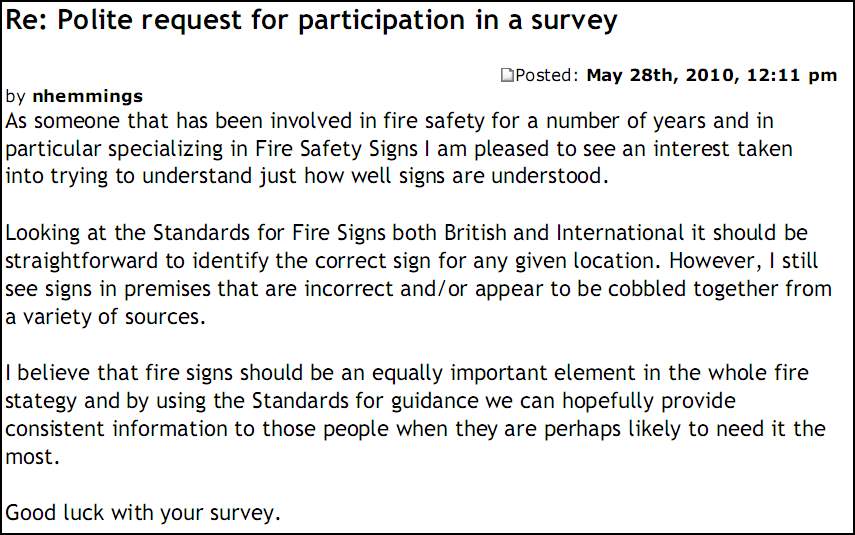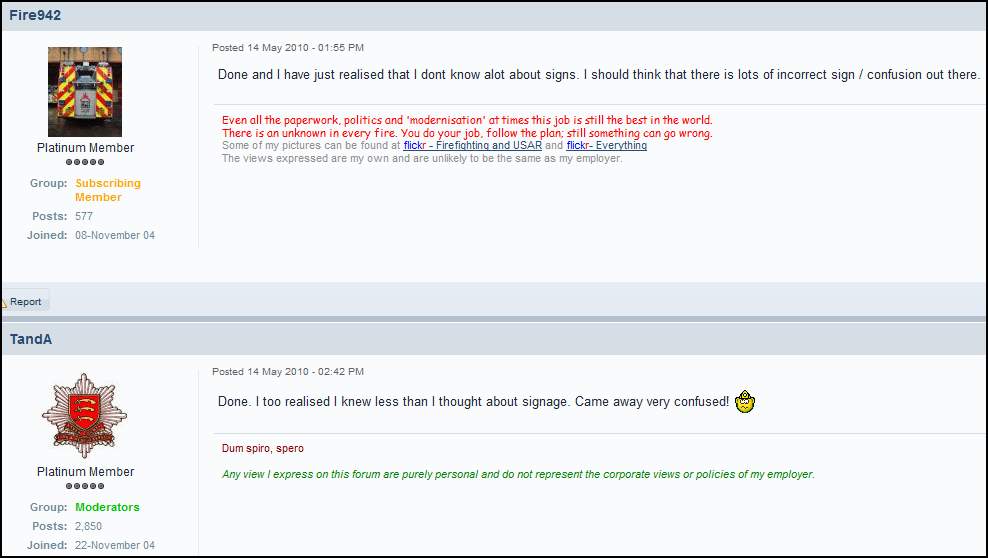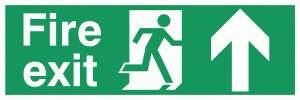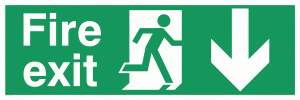Where and Why Do We Actually Need Fire Safety Signs and Do We Fully Understand the Requirements?
Info: 9585 words (38 pages) Dissertation
Published: 9th Dec 2019
Tagged: Health and Safety
| 1 ABSTRACT & SUMMARY |
- Current legislation in the United Kingdom requires every employer to ensure that workplaces where necessary are provided with suitable fire safety signage (The Management of Health and Safety at Work Regulations 1999 (SI 3242). Her Majesty’s Stationery Office, London) and consequently employees must be able to understand the meaning of these signs and be able to follow the intended instructions in conjunction with the appropriately displayed fire safety notices.
- After months of comprehensive research, this paper identifies why and where there are successes and failures in the application and understanding of the regulations.
- Explores why there are existing issues related to, the misunderstanding of the purpose for fire safety signs and fire instruction notices.
- Analyses of the application of the legislation and discovers why frequent inconsistent compliance exists with these regulations, published standards and guidance documents by persons responsible for conveying the correct intended meaning and purpose of these signs and notices.
- To reduce the damage caused by un-necessary complicated situations this paper recommends simpler, clearer, up-to-date guidance be produced for all persons involved in the purchase, design and use of signs. One of many possible options would be to set up a regulated information gateway in the form of a dedicated up to date website, controlled by a recognised body and complimented by a similarly regulated single informative guide. This more effective control measure would then be able to halt the inconsistent ad hoc interpretations of the regulations and circumnavigation of the correct scrutiny processes of the relevant technical committees, thereby allowing for a safer single secure approach to the interpretation of the required legislation. The only drawback to this is the fact that due to the current fiscal climate the setting up of a new government led body may be deemed too costly.
| 3 CONTENTS PAGE |
| 1 Abstract & Summary | Page 1 |
| 2 Acknowledgements | Page 2 |
| 3 Contents Page | Page 3 |
| 4 Introduction | Page 4 |
| 5 Main body | Page 7 |
| 6 Conclusions | Page 20 |
| 7 Recommendations | Page 29 |
| 8 Appendices | Page 32 |
| 9 References | Page 33 |
| 10 Bibliography | Page 35 |
|
- The analysis of this problem does not include all Safety Signs & Notices to which the Regulations and other relevant documentation later mentioned in this paper apply. This paper focuses on three main topics, the principles governing the design and application of various signs used to create a Safety Way Guidance System (SWGS); the design of signs used to identify the location of fire equipment, the format and use of suitable Fire Action Notices.
- Additionally, further dissection of this subject area is required in order to preclude the special considerations of possible tactile or audible components of a SWGS. This means, it is necessary to limit the subject matter and concentrate on Fire Safety Emergency Escape Signs, Fire Equipment Signs and Fire Action Notices and the different ways in which the legislation requiring these signs is interpreted. The use of illuminated signs; the use of acoustic signals, verbal communications and hand signals; the more general health and safety hazard signs for packaging and pipelines; and prohibition and mandatory signs are not discussed in this paper[I].
- The use of signs and notices are currently required in certain circumstances in most workplaces under various pieces of United Kingdom and European Legislation. This legislation applies by default to all persons in the United Kingdom – where a clear understanding and ability to interpret the signs is of paramount importance – regardless of whether the persons affected by the use of signs and notices are employees, self-employed, or visitors to the relevant workplaces.
- This paper discusses the issues created by the mass of existing information contained within the regulations and identifies why and where there is a varying degree of interpretation and misinterpretation. Quite often, the problems are because of the low standard of the training delivered to employees and the ability of fire safety professional from different disciplines to fully analyse and understand the regulations that enable compliance. This is a view shared in 2004 by Jim Creak – Chairman of the Health & Safety Signs Association and editor of means-of-escape.com: and Allan Asher – Chairman of the Consumer Policy Committee of the BSI. (See figure 1).
| Figure 1- from BSI website press release 15 July 2004 |
 |
- This paper also sets out to: investigate the common issues; analyse why misunderstanding of the current signs and notices exist; explore the reasons for and levels of complacency which seem to exist; and suggest how best to counteract these common issues. It further explores why there seems to be an ‘anything goes as long as it’s something’ slap dash approach to meeting the compliance of appropriate signage requirements in terms of correct selection and positioning. In support of this observation, evidential analysis suggests that the displaying of the correct combination, design and quantity of fire safety signs should follow more closely the guidance contained within the European Regulations and British Standards, which at present, when jointly referenced, are somewhat ambiguous and open to loose interpretation.
- The common issues in the practical application of the Regulations are identified in three fundamentally important areas:
- Firstly, there is no direct regulatory enforcement of the sign manufacturers, distributors or sellers. These companies create websites that design, produce and sell signs that may either comply, loosely comply or plain simply do not comply with the standards. These signs are then sold freely in the belief of the seller and purchaser that the sign is correct and meets the standard. This malpractice is fuelled by the Guidance on Regulations to the Health & Safety Signs & Signals Regulations 1996, HSE Publications, paragraph 37 which states ‘Small differences from the pictograms or symbols shown in schedule of the Regulations are acceptable…..’ and where BS 5499-4:2000 clause 4.4 says ‘To avoid confusion, all signs within a system of escape route signing should be of similar style, design, size and format’. The non-intentional confusion by both documents can mislead the reader by them simply focussing on the words ‘small differences’ and ‘similar’. Although the context of the sentence in the BS actually refers to the configuration of the layout of the signs three main components: the ‘running man’ the supplementary text and the arrow being similar it does not intend to mean the design of each is allowed to be similar (see figure 3).
- Secondly, a fair proportion of building owners, facilities managers, safety managers, and others responsible for selecting and installing fire safety signs are not fully conversant with the requirements of BS 5499-10:2006, which tells them how to select, install, position and maintain fire safety signs. This is evident when dealing with contractors and designers quoting the incorrect part of a British Standard and the buildings displaying over engineered signage that is either excessive in the number of signs, or the wrong size signs are displayed (see final photograph in figure 9).
- Thirdly, there is insufficient effective training that specifically conveys the meaning of the signs displayed to the intended viewer. This issue particularly affects employers, where even though they know that signs are required, they often overlook the quality and suitability of training for their staff, in terms of understanding what the specific signs displayed in the workplace actually mean.
| 5 MAIN BODY |
- A Safety Sign & Notice Comprehensibility Survey (see appendix 1) was created on the internet, and ran from 12:15 on 7th May 2010 to 00:00 (midnight) on 30th June 2010 and had 444 participants. It proves that there is currently much confusion with understanding Fire Safety Signs & Notices – which includes the designing, intended meaning, selection and placement of the signs – in most parts of the United Kingdom. The survey captured an ‘on the spot’ response from a wide demographic of the population in the United Kingdom, taking anonymous instantaneous answers from the general populous. The participants of the survey included experienced fire safety professionals, fire safety officers (retired & serving), the military and those with little or no fire safety experience from the public and private sector.
- The results (see Appendix 2) show that out of the three main areas: fire equipment signs, fire action notices and fire escape signs; the fire escape signs are the most complicated to understand. This is no doubt due to a lack of training that emphasises the signs used in the workplace and although the survey participants possess a basic understanding the reasons for fire safety signs seems to be not that important. It is probable that signs are treated as passive indicators of what to do in the event of a fire and not actually an active part of an emergency instruction. They do not actively perform in the same way as a fire alarm sounder, flashing beacon or any other automatic device does as part of the fire escape plan. Therefore, they are seen as supplementary guidance, and of little importance. It may also be the case, because these signs have many more configurations than fire equipment signs they are again wrongly viewed as being complicated in their design – when in fact there are only a maximum of three main component parts that make up a sign as already mentioned in paragraph 4.6.1.
- Conversely, the survey showed that fire equipment signs are easier to understand, as there is little design fluctuation possible with such simple signs having only one part (symbol) which may or may not be supplemented by text. However, in particular, the sign with the fire helmet does not bear much relation to representing a fire point because most survey participants thought it meant wait in the building for the fire service and a few others thought the helmet was there for use in a fire. Interestingly, there is no single identifiable problem area for those that took the survey, instead there are many shared issues spread across the survey. This broad range of a lack of understanding is analysed in appendix 10 and overall there is strong evidence to suggest that there are some serious issues with:
- Those who may need to rely on the signs in an emergency, as they might not really understand the message conveyed through a lack of information or training,
- Those with the responsibility for manufacturing, in some cases misinterpreting the regulations and,
- Those responsible for introducing the signs in the workplace not adhering to the requirements of the signing conventions due to a general lack of understanding of the requirements.
- These issues are found to be existing and seem to be a consistent concern in recent years. This observation, is supported by the Health & Safety Signs Association, who issued a press release in July 2004 on the British Standards Institution Website in which it highlighted concerns ‘that the public did not possess a clear understanding of the signs’, and saw the need to announce this fact with great concern (see Figure 2).
| Figure 2 – HSSA concern over public confusion July 2004
|
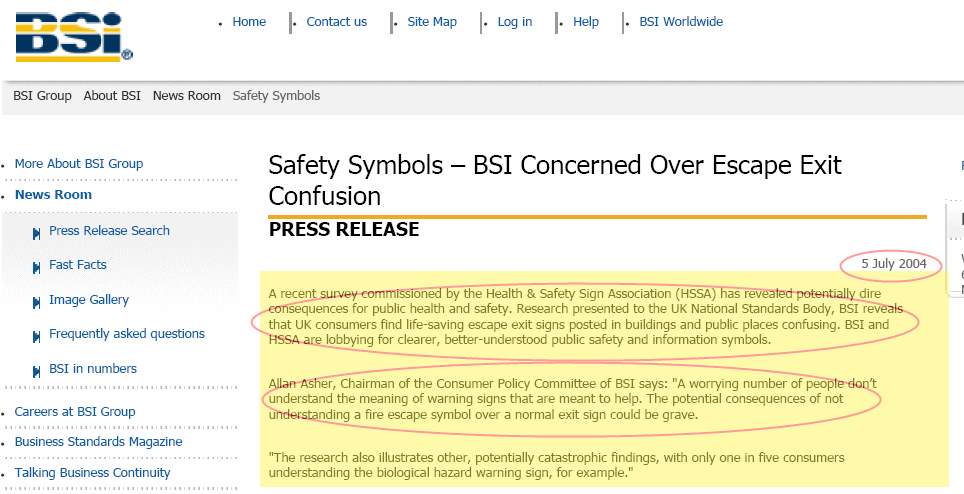 |
- To date, these largely unchanged problems are being sustained by the lack of education and the various unregulated websites offering signs and notices for direct purchase. To illustrate this point, a few examples of ad hoc signs that do not follow the regulations were extracted from the internet at the time of writing this paper. To the inexperienced, it would be difficult to determine if these signs complied sufficiently.
- The first example (see Figure 3) uses the correct shade of the colour green, which identifies it as a fire escape sign, but the actual symbols look like they have been hand drawn with the tapered door and the stairs represented as a jagged line, neither of which are a recognised pictograph design.
- The second example (see Figure 4) looks more like the recognised pictograms but uses two arrows rather than one. This contravenes BS 5499 Part 1:2002 Clause 7 & BS 5499 Part 6:2002 Clause 6, which both refer to the statement “Each safety sign shall be used to convey only one safety message in accordance with BS 5499-1:2002, 11.3.”
| Figure 3 – Website Selling Ad Hoc signs – found 10 May 2010 Sign not featured in 92/58/EEC nor BS 5499
|
 |
| Figure 4 – Another Website selling Ad Hoc sign found 9 May 2010
|
 |
- In addition, there are now signs appearing that comply with British Standard BS 5499-1:1990 and portrayed to be compliant with the Health Technical Memorandum 65 (HTM 65). These particular signs are favoured in the National Health Service (NHS) by a Poll[II], which sees flames from the fire equipment signs added. The development and adaptation of this type of sign is outlined in the following (Figure 5) to show where it does not comply with the correct standards.
| Figure 5 – showing adaptation of the NHS guidance |

NHS POLL RELATED FPA CATALOGUE WITHIN IFE FRM MAGAZINE
STATEMENT OF POLL RESULTS FROM WITIHN THE FPA CATALOGUE
|
- The key factor to all this misinterpretation is legislation, which is the main driver in the United Kingdom for the implementation of Fire Safety Signs & Notices, as it has always had the ability to present itself as inherently complicated. This is because the legislation is written in legal terms that can be confusing to the layperson and because the relevant information can be interpreted slightly differently by different people, the result is all too often an uncertain interpretation of the law, which can often go unchecked for lengthy periods. It would be better written in plain English to enable the reader to understand how to comply with the law.
- Moreover, the crucial point here also is that some, if not all, of the relative documents (see Appendix 3) may be assumed to be legally binding and unless fully understood they cannot be taken for their intended purpose and applied correctly. After all, legislation is quite complex in its referral to Acts, Regulations, Orders, Approved Codes of Practice, Standards and Guides. Therefore, a function or purpose of each document and their legal status is shown in the columns of appendix 3, which aims to inform the reader just how much information they may encounter in order to provide the correct compliant sign in the workplace. The table however, does not include ACoPS or Guidance notes, but does include the more relevant Acts, Regulations, Directives, British and International Standards.
- With an understanding of the information within these documents, it is possible to deduce that there is a LEGAL requirement to have signs in the workplace if after a risk assessment and measures have been put in place, a residual risk remains. What is not clear particularly when reading the British Standards (BS) and the Health & Safety (Signs & Signals) Regulations (HSS&SR) is what signs are actually required? This is made more confusing as the BS contains more relevant information than the HSS&SR and some of the signs are different in each document. Legislation in the form of regulations also tells us that if signs are deemed necessary then training of the meaning of those signs is a requirement.
- Notwithstanding the contents of Appendix 3, the difficulty in obtaining the correct sign is simulated here. Where, as the result of a fire risk assessment in a workplace there remains a residual risk that the persons employed there do not recognise that a collection of fire equipment is to be called a Fire Point and has to be signed accordingly. The following paragraphs show the employer having the ‘simple’ task of finding the correct sign to highlight a fire point in the workplace. The obvious choice being the internet as the first port of call, rather than engage a specialist consultancy firm for advice. A single sign is sought in this example: More signs of different types would be even more confusing if the employer were to do this on their own without specialist advice.
- Crucially, there is an obligation on the supplier / manufacturer to supply Fire Safety Signs that comply with the current regulations. The employer may not have the opportunity or time to digest the relevant guides and regulations as shown previously in Appendix 3, opts to find the right sign in the quickest and most cost effective way. Relying on the internet as most people do and finding after visiting a few websites the choice of signs are, as shown in (Figure 6) below.
| Figure 6 – Suggested signs as identified on internet search term for “Fire Point Sign” | |
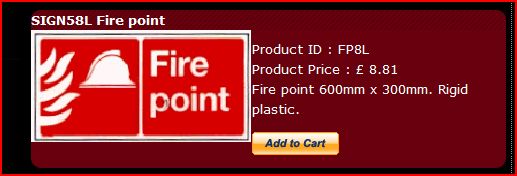 |
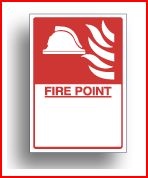 |
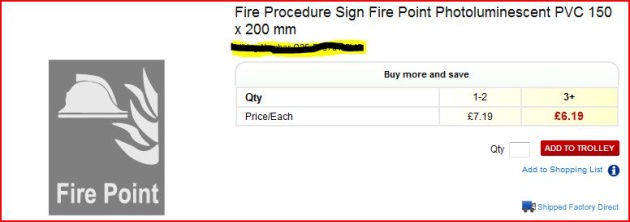 |
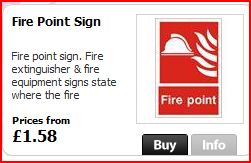 |
 |
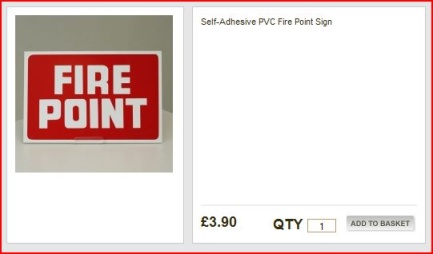 |
- As can be seen from the figure above, the employer is presented with many different types of sign and this may cause the employer immediate confusion. It may be that the sign with the lowest cost or the sign that is most appealing is chosen as the right one. “What about the £19.25 Glow in the Dark sign should the employer go for that one? What does the risk assessment specifically indicate is required? Must the sign have words? Maybe the £1.58 Sign is the right one. It is after all on a website being sold by someone in the know.”
- This unregulated freelancing of sign design is entwined in a world of self-perpetuated confusion. What is disturbing is that the websites generally sell signs that comply with the current regulations alongside those that do not. The inexperienced employer then believes that compliance is reached if one of these signs is purchased for the workplace. However, this may be the case and compliance is achieved, but equally the wrong sign may be purchased and compliance is assumed, but not achieved.
- To put this simulation into further context, in another example the same employer requires an exit route to be signed and carries out the same procedure to procure a compliant fire escape sign. Once an internet search is performed again, a very different collection of websites offer anything from brightly coloured green signs not conforming to the colour standards to light emitting diode type signs (see Figure 7).
- In addition, a statement that provides inaccurate guidance and does not answer the customers’ question accompanies the sign at the bottom of Figure 7. For example, the customer is asking if the fitting of the sign complies with BS 5266 Pt 1 and the design is compliant with BS 5499. The answer explains that the design complies with BS 5266 part 1 when in fact it does not even comply with 92/58/EEC or the HSS&SR either. The customer is actually asking if the design complies with BS 5499 not BS 5266 and therefore this shows that the person answering does not know the difference between the two separate British Standards. This is just one of many examples that can be found to give information that does not accurately reflect the guidance.
- As well as this, there is more incorrect information that is very popular and not surprisingly, this can be seen in the second pictured example in Figure 7. The website here, advises that the BS 5499 and 92/58/EEC signs should not be mixed, which is not conducive to the guidance in the HSS&SR or the HSE guide that accompanies it – both documents state that both signs are acceptable. Furthermore, it is found quoting the HTM 65, which was replaced in 1999 (see paragraph 5.6).
- Continuing on this theme, the guidance in BS 5499 may also be followed because it supports the use of pictograms on the signs. It includes the use of text and mentions that a white man on a green background should be used for externally illuminated signs unless it is internally lit. Furthermore, the BS is quite informative about the measurements and colours of the signs whereas the HSS&SR is not, and although both BS 5499 and HSS&SR are quite prescriptive in their use of the correct pictographs, paradoxically both documents include statements that allow slight unspecified variations to the designs.
| Figure 7 |
 |
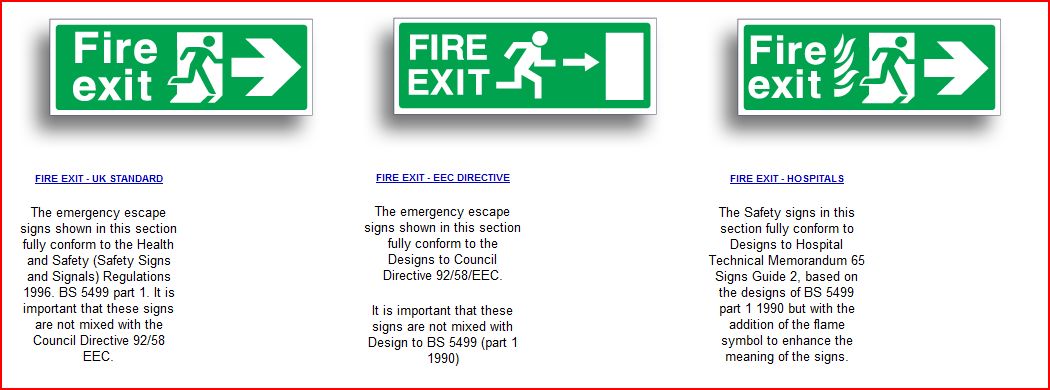 |
 |
- The final topic discussed in this paper is the provision of suitable Fire Action Notices. There are many notices available; they range from having excessive lines of instruction to having very little text to compliment the pictograph (see Figure 8). The intended purpose of these types of notices is to pass specific instruction to staff or members of the public to ensure they take the correct action in a fire emergency. However, there is no specific standard for these signs and consequently any right or wrong way to produce a sign, as they are situation specific. In all cases, what is overlooked is the fact that they should be easily understood by the use of different ‘regulated’ pictographs and use as few words as possible. The education of sign creators and Building Fire Safety Managers in terms of displaying these signs correctly is critical – as they should decide on the message conveyed by these signs in the relevant areas of a workplace.
| Figure 8 – showing a selection of very different signs, all conveying their intended meaning, but in very different ways |
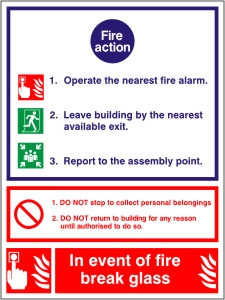 |
| [A] |
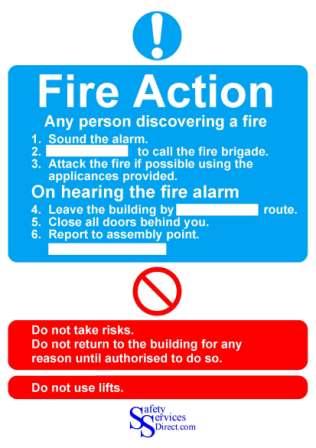 |
| [B] |
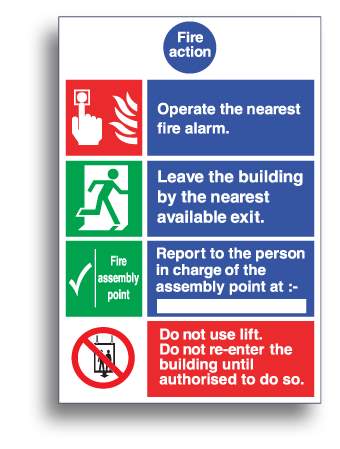 |
| [C] |
- The signs on the previous page show that there is no single design that can be adopted in order to limit any oddities in the finished sign. But, as good as these signs are they still have flaws in their design, as follows:
- Sign A is quite specific and gives simple instructions but has the call point pictograph repeated with two different supplementary text sentences. The lower pictograph and text is not required but to the unversed may cause confusion as it repeats the first action at the top of the sign. This sign seems to be intended for members of the public to evacuate the building, as there is no instruction for them to make an emergency call to the Fire & Rescue Service and there is no requirement for them to attempt to fight the fire. This sign is suited to sleeping accommodation and places of public entertainment and is fully compliant with HSS&SR. The meaning intended by this sign does not have to be supported by specific supplementary training.
- Sign B is for any staff but not for members of the public. It tells the person discovering the fire to raise the alarm, make an emergency call, attempt to tackle the fire and go to a specific assembly point via a specific named route. It also instructs those hearing the alarm to close all doors as they escape via a route specific to the area they are in and go to a specific assembly point. This type of sign complies with the HSS&SR only because it includes two pictographs. The use of text to convey twelve instructions is acceptable provided the correct training is given, which would probably be the case, particularly where some employees may not be able to read English, for whatever reason. The most probable use of this sign would be in large industrial type premises where different sections of a factory evacuate via specific routes to specific assembly points.
- Sign C is fully compliant with HSS&SR and easily understood in a short period. Unlike sign A, it does not have any repetition of needless instructions or duplicate pictographs. This type of sign suggests that the initial firefighting and call to the emergency services would be taken by a designated person or persons, maybe a Fire Warden. The reader of this sign would possibly be familiar with the building and by default the specific assembly point known.
- The importance of Fire Action Notices providing the correct message to the specific reader to enable in the shortest time and by the most quickly understood message; the actions to be taken in the event of a fire: against a fire action notice that reads like a chapter of “War and Peace”.
- Real life photographs were taken from inside two different General Hospitals during the course of writing this paper to back up the notion that an NHS poll has not been enforced in South Wales. Equally, to show a severe misunderstanding of the requirement for the correct sign size a snapshot was taken off the TV – a good source of viewing incorrect signage. Two signs can be clearly seen in an ‘antiques warehouse’ and are placed on the rear wall – a ridiculous viewing distance that could be calculated to miles instead of metres must have been considered to provide such large signs (see Figure 9).
- As can be seen from all of the signs displayed in the preceding and following figures, there is a mixture of standards of supplementary text. There is an actual standard, in the UK often completely disregarded and comes from BS 5499-1:2002, paragraph 12.2 which states:
‘The initial letter of the first word shall be upper case and the remainder of the wording shall be lower case. Where a signal word is used on a supplementary text sign used with a hazard sign (see 10.4) the text after the signal word shall start on a new line; the initial letter of the first word shall be upper case and the remainder of the wording shall be lower case.’
5.23 This first sentence actually applies to fire safety signs and actually means that the word ‘Exit’ should be written with a first capital letter and the words ‘Fire Exit’ should also have a capital at the beginning of each word. The reference to signal words in the second sentence of the standard relates to the words Danger – Warning – Caution predominantly found of H&S Hazard signage, which does not apply to fire safety signage per se.
| Figure 9 – real life photos of signs |
  |
| These signs are taken from two nearby hospitals – no flames |
 |
| The signs on the rear wall are oversized and probably worth more than the antiques in the hall! |
|
- The abundance of complicated rules & regulations written and enacted over many years is not for the faint hearted and therefore, it is suggested, not fully digested and by default – not thoroughly understood (see paragraphs 5.8 and Appendix 3). It is therefore difficult for a ‘responsible person’ to stay within the rules & regulations, if they require something as simple as a few signs. (See paragraphs 5.10 – 5.16).
- Even with the engagement of ‘experts’ when attempting to become compliant with the regulations, the employer unknowingly may take what they believe to be the sufficient actions to ensure compliance and could fall short of the requirements. This compliance is something that is seldom measured, unless focussed on by the relevant enforcing authority under the RRFSO 2005. Extraordinarily, if there is an incident that results in the exposing of non-compliance in an existing building or at the time of design the relevant Authority’s lack competence in advising on the selection and installation of the correct signage, these issues will often go unchecked.
- Evidence shows problems with the design, supply, application and understanding of the meaning of signs has been around for a considerable number of years (see paragraphs 4.4 & 5.4). During this paper, it has been discussed that websites offering signs are an integral part of a larger miscommunication problem. In an attempt to prove this, an email was sent to a company, chosen at random, to find out the response to a simple question, about the up and down arrows on a fire escape sign. The reply shows that the person giving advice does not fully understand the advice she is giving (see Appendix 8). This is one example of how little understanding there is, in terms of interpretation of the standards, when it comes to supplying and designing signs and to ensure the correct meaning given is in accordance with the standards (see paragraphs 5.5; 5.6; 5.11; 5.15 & 5.17). It is clear that the BS 5499-4:2000 is not fully understood as although the response is fairly accurate she omits to be clear that the sign with the arrow pointing down does not mean progress forward from here. This could therefore lead to this sign being used where the sign with the up arrow should be used (see Figure 11). The signs are extracted from the BS 5499-4:2000 table 1 – Escape route signs (meaning and use of graphical symbol with directional arrow).
| Figure 11 |
 |
- Another factor, which does nothing but present another additional complication to the application of the regulations, is that presently the HSS&SR directs persons to follow the European directive 92/58/EEC which introduced the white running man, a white arrow and a white solid door as the 3 main elements on a green background for a fire escape sign. Unlike BS 5499, it neither mentions the use of text where necessary nor the single use of capitals on the first word only.
- Confusingly, it assumes no text would be used on this sign because it would detract from its main purpose of being understood by a multilingual group of European countries and is better served by the preclusion of text rather than have three or four of the main European languages displayed on the sign. However, this is not fully understood by the sign designers et al, as quite often the ‘Eurosign’ is seen with Text on it in the United Kingdom. Whilst this may be argued to be within the standards, it can also be argued that the text being supplementary is not required for this sign and therefore not capable of causing confusion to those that cannot read English; visiting or living in the United Kingdom. The thought process here being that no language would be better than the wrong language – biased by a culture of litigation. The interesting point here with regard to the justification of using a capital letter on the first letter only on the first word of supplementary text as mentioned in paragraph 5.22, is probably due to the ability of those persons with dyslexia finding it difficult to understand the text. A query was raised to support this probability in an email to the British Dyslexia Association and the interesting reply (see Appendix 6).
- The issue where individual interpretations are allowed to be advertised as ‘best practice’ to those that rely on specialist advice; and taken as fact seemingly unquestioned by different organisations (see paragraph 5.5) is disconcerting. The current advertising of the fire escape sign with flames which claims to be in compliance with HTM 65 (see paragraph 5.6) is questionable because HTM 65 was replaced by a publication called Wayfinding in 1999 – The latest version being ‘Wayfinding – effective wayfinding and signage systems guidance for healthcare facilities’, 2009 (see Appendix 4). Strangely, there is no evidence of this NHS Poll that can be found during the writing of this paper and the proclaimers have only chosen the BS 5499 sign design and not that of the EEC directive, for reasons unknown.
- Equally concerning is that there are a large number of websites and magazines, following this guidance and quoting that the flames are a requirement of HTM 65 and for use specifically in Healthcare premises. This can only be described as ‘chain reaction’ quoting. Interestingly, the Wayfinding document mentioned above declares the escape signs may be used with flames and therefore it is not compulsory (see Figure 10), either way the question remains if it is enforceable, which is doubtful as all evidence seems to point to it being a made up design. In an n effort to gain supporting bona fide evidence of the NHS Poll a question was asked on the website forum of a well know sign manufacturer who published a catalogue of signs in one of the latest Institute of Fire Engineers’ magazines and to date no reply has been put forward (see Appendix 5).
| Figure 10 – Extract from Wayfinding mentioning flames |
 |
- It has also been discussed that according to this Poll undertaken within the NHS, flames are preferred on signs that are used within Healthcare premises of all types. With this in mind, it was decided to investigate this inference a little further in an attempt to find out if there were any reasons why there was no mention of any other combination of pictogram in terms of using the pictograph for wheelchairs on these signs combined with the flame. Therefore, as before, a random website was chosen to provide the answer. The response (see Appendix 9), although accurately provided in the context of BS 5499-4:2000, shows the company’s understanding that it is only the NHS that require flames on their signs. In this example, although this website only shows that it provides standard ‘running man’ type signs with flames (see Figure 12). The responsible person wishing to purchase a wheel chair escape sign may end up with a standard wheel chair sign offered by the company website without flames in an NHS premises (see Figure 13). Unless by chance, they specified the inclusion of flames on a wheelchair sign, which would without doubt then be provided at, and slightly higher cost.
| Figure 12 – including standard quote of outdated HTM 65. |
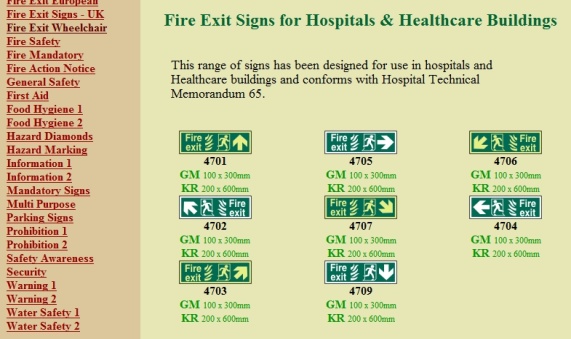 |
|
Figure 13 – no flames on these |
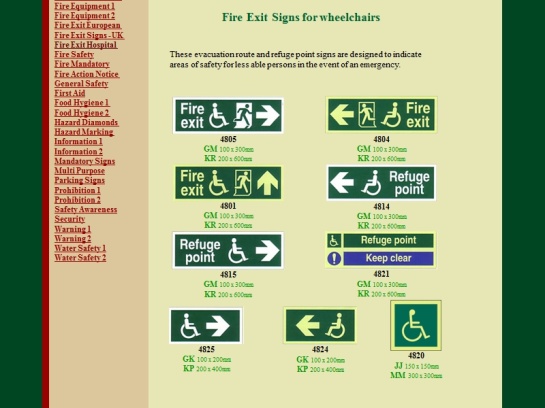 |
- Remarkably, the BS is not a legal requirement and therefore does not have to be followed closely if there is a suitable alternative. However, the HSS&SR is of Legal Status and has to be followed because it was written to support the European Directive 92/58/EEC that insisted on the compulsory use of pictographic symbols. That said there are also statements being relayed by sign suppliers that advise against the use of both standards as they may cause confusion. Yet another implausible consequence derived from some unidentified source and brought about by the fact that a luminaire will be supplied automatically with the ‘Eurosign’ backlit lens and be mounted in an area where existing BS 5499 Vinyl Adhesive signs are mounted on adjacent walls. Another question was raised to one sign supplier in terms of cost to supply a BS 5499 luminaire instead of the ‘Eurosign’ and the cost was a surprise (see Appendix 7).
- The research performed during the writing of this paper ventured in to the realms of how international standards are decided upon and eventually implemented as legislation or United Kingdom standards. This involved contacting many of the organisations early on, to establish just how much of the legislation, rules, standards and other documents specifically related to fire safety signs currently in force or applicable at this time. Some of the organisations were asked various questions in terms of the origins of sign and symbol design and a deeper understanding of the processes and purpose or function of these committees was gained.
- Within these organisations, the different committees are constantly reviewing and updating the regulations. For example, the process for implementation of the standards in the United Kingdom is laid out in a simplified flow chart on the next page (see Figure 14). It shows the routes that may be adopted to bring a standard from the International stage to the shores of the United Kingdom, whether they are enforceable or adopted voluntarily as best practice. In short, the BSI is a member of ISO[III] and CEN; and the HSE adopts CEN standards as EEC Regulations because CEN adopts ISO standards by official agreement.
| Figure 14 |
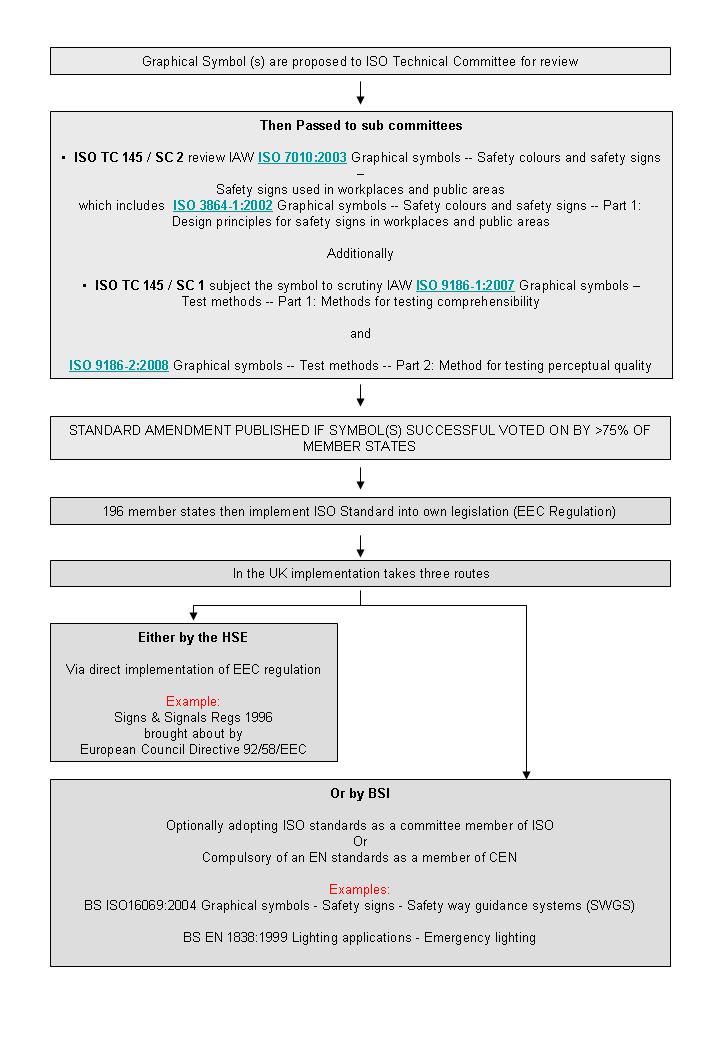 |
- Throughout this paper, there have been references to the manufacturers / suppliers and employers misunderstanding for correct signs. Reference was made in paragraph 5.1 to the creation of a survey, of which the results can be found at Appendix 2 that captured the general populous level of understanding. A further detailed analysis of these responses and answers to these questions can be found at Appendix 10. As far as the fire safety professionals are concerned, their responses were only slightly better than non-fire safety professionals were. By their own admission, in the main there is a general feeling from this group that they also recognise it as a big problem as this paper is proving. Examples of emails from fire officer colleagues and forum posts from some of the leading fire safety consultants shown in the following figures (see Figures 15 & 16).
| Figure 15 – Fire safety colleagues admissions |
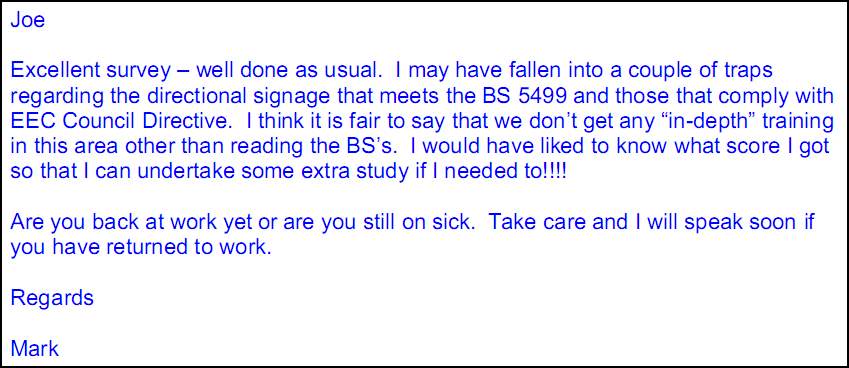
|
| Figure 16 – Forum posts |
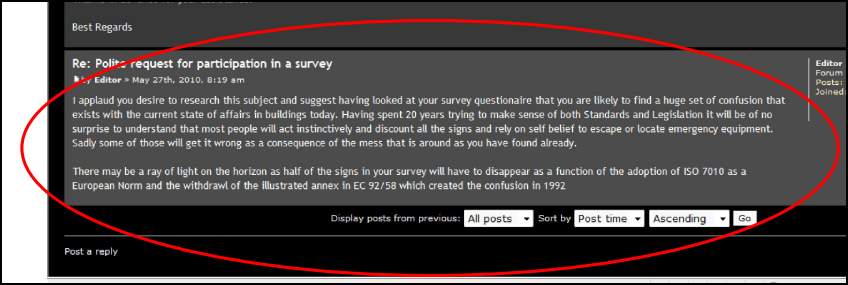
|
6.13 The major issues have been discussed so far and one of the larger problem areas identified would be the assurance that staff are given specific effective training in the recognition of fire safety signs and fire action notices. This should be promoted more vigorously by enforcing authorities and specialist consultants. They and the employers need to be reminded that is a legal requirement to provide suitable and sufficient staff training under the Health and Safety (Safety Signs and Safety Signals) Regulations 1996 Clause 5 as follows:
‘Information, instruction and training
5.—(1) Every employer shall ensure that comprehensible and relevant information on the measures to be taken in connection with safety signs is provided to each of his employees.
(2) Every employer shall ensure that each of his employees receives suitable and sufficient instruction and training in the meaning of safety signs and the measures to be taken in connection with safety signs.’
|
- The HSS&SR needs to be withdrawn or completely rewritten – as it will become obsolete with the advent of ISO 7010 in terms of the ‘Eurosign’ fire escape signage. Therefore, the statement about the two types of sign being mixed as bad practice and the confusion brought about HSS&SR will no longer exist (see Appendix 3 / paragraphs 6.4 & 6.9).
- A guide should be produced and a single website should be created (or a section on direct.gov et al created) by a single responsible authority – This should be the sole reference for all sign manufacturers to use for sign design. Before they are allowed to sell signs, they must pass a level of certification to show they understand what they are providing to their customers or prove that the design of the design follows the new simplified guide. After all, since the publication of Approved Document P, you now have to be a competent electrician to carry out most electrical works and you cannot fit a gas boiler unless you are Gas safe registered. It should not be different if you are selling fire safety signs, especially fire escape and instruction notices (see paragraphs 6.3; 6.6 & 6.7).
- Enforcing authorities should assess the signs for suitability against a set of defined standards and building control / fire safety consultants should make themselves more familiar with the standards. This is where an intimate knowledge of the requirements of BS 5499-4:2000 is important and goes hand in hand with BS ISO 16069:2004; and if they are read in conjunction with one another can only enhance understanding of the requirements (see paragraph 6.2).
- Appropriate Workplace sign recognition training is required – The lack of training in terms of deciphering the meaning of the signs by employers and employees needs to be addressed by including the identification of signs in the workplace and ensuring training packages are revised. Not just delivered off the shelf, as standard training packages (see paragraph 6.13).
- A new sign for forward level escape should be put forward to the BSI committee. There should be clear designation of the type of sign used for continuous escape through an escape route that passes through several doors without a change of level or left/right direction, to replace the sign with the up arrow which has two meanings thereby alleviating the confusion caused by the meaning of this sign (see Figure 18 / paragraph 6.11).
| Figure 18 – Additional proposed BS 5499-4 sign for onward escape |

Replacement sign for continuous forward level escape to be added to BS 5499-4 Table 1
This sign can then revert to one meaning (progress up from here) and table 1 amended
It would be more akin in meaning to this sign (progress down from here) |
- The fire exit sign over a final exit should be determined to have supplementary text with the words Exit written on it – Even though this is mentioned briefly in clause 4.7 of BS 5499-4:2000 (see Figure 19), the examples in table 1 and the figures in Annex A of the BS are not presented clearly enough, are confusing and in need of revision (see paragraph 6.11)
| Figure 19 |
 |
- There should be a simple instruction to the reader of BS 5499-4:2000 similar to this, and table A.18 should be amended along with a revision of the other table mentioned above (see Figure 20).
| Figure 20 |
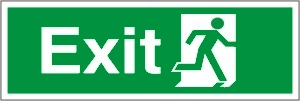 |
| A supplementary text sign reading “Exit” should be used with an escape route sign to indicate a doorway or other suitable opening that leads to a place of safety. No other sign should be used. |
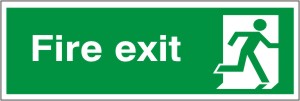 |
| A supplementary text sign reading “Fire exit” should be used ALONG an escape route BEFORE a doorway or other suitable opening that leads to a place of safety is reached. The use of an appropriate single arrow is also required when using this sign to indicate the direction of travel. |
| 8 APPENDICES |
Appendix 1 – Fire Safety Signs & Notices – Comprehensibility Survey.
Appendix 2 – Results of Fire Safety Signs & Notices – Comprehensibility Survey.
Appendix 3 – Legislation Simplified chronological table of relevant standards and Regulations.
Appendix 4 – Email confirming HTM 65 superseded.
Appendix 5 – Question posted on Jalite Forum asking for NHS Poll Survey for flames on signs – not answered.
Appendix 6 – Response from British Dyslexia Association confirming Capital Letters difficult to read.
Appendix 7 – Email asking company why Eurosign luminaire not provided as BS 5499 and enquiring about HTM 65 with standard response.
Appendix 8 – Email to sign company requesting information on signs meaning with up / down arrow.
Appendix 9 – Email to company asking about why wheel chair signs are without flames – standard response.
Appendix 10 – Fire Safety Signs & Notices – Comprehensibility Survey – Compilation of answers and analysis of responses.
| 9 REFERENCES |
The Management of Health and Safety at Work Regulations 1999 (SI 3242). Her Majesty’s Stationery Office, London
The Health and Safety (Safety Signs and Safety Signals) Regulations 1996 (SI No 341) Her Majesty’s Stationery Office, London
British Standards Institution (2002) Graphical symbols and signs. Safety signs, including fire safety signs. Specification for geometric shapes, colours and layout. BS 5499: Part 1:2002. British Standards Institution, London
British Standards Institution (2000) Safety signs, including fire safety signs. Code of practice for escape route signing. BS 5499 Part 4:2000. British Standards Institution, London.
British Standards Institution (1976) Framework for colour co-ordination for building purposes BS 5252:1976 British Standards Institution, London
British Standards Institution (1996) Specification for colours for identification, coding and special purposes BS 381C:1996 British Standards Institution, London
British Standards Institution (2000) Safety signs, including fire safety signs. Code of practice for the use of safety signs, including fire safety signs. BS 5499 Part 10:2006. British Standards Institution, London
National Health Service Estates (2005) Wayfinding: Effective Wayfinding and Signing Systems – Guidance for Healthcare Facilities. Her Majesty’s Stationery Office. London.
British Standards Institution (2002) Graphical symbols and signs. Safety signs, including fire safety signs. Signs with specific safety meanings (Specification for additional signs to those given in BS 5378: Part 1) BS 5499: Part 5: 2002 British Standards Institution, London.
British Standards Institution (2002) Graphical symbols and signs. Safety signs, including fire safety signs. Creation and design of graphical symbols for use in safety signs. BS 5499 Part 6:2002 British Standards Institution, London.
British Standards Institution (2006) Safety signs, including fire safety signs. Code of practice for the use of safety signs, including fire safety signs BS 5499-10:2006. British Standards Institution, London.
BS ISO 16069: 2004 Graphical symbols – Safety signs – Safety way guidance systems (SWGS) British Standards Institution. British Standards Institution.
| 10 BIBLIOGRAPHY |
Act of Parliament (1974) Great Britain Parliament. The Health and Safety at Work etc. Act 1974. Her Majesty’s Stationery Office, London.
The Regulatory Reform (Fire Safety) Order 2005 (SI 1541) Her Majesty’s Stationery Office, London.
ISO 6309:1987 Fire protection – Safety signs. International Standards Organisation.
European Council Directive 89/391/EEC of 12 June 1989
European Council Directive 89/654/EEC of 30 November 1989 concerning the minimum safety and health requirements for the workplace
European Council Directive 92/58/EEC of 24 June 1992
ISO 3864-1:2002 Graphical symbols — Safety colours and safety signs — Part 1: Design principles for safety signs in workplaces and public areas. International Standards Organisation.
ISO 7010: 2003 Graphical symbols – Safety colours and safety signs – Safety signs used in workplaces and public areas. International Standards Organisation.
ISO 3864-3: 2006 Graphical symbols – Safety colours and safety signs – Part 3: Design principles for graphical symbols for use in safety signs. International Standards Organisation.
ISO/DIS 7010 – Graphical symbols — Safety colours and safety signs — Registered safety signs.
Department for Communities and Local Government (2006) Fire Safety Guide – Healthcare premises 2006. Department for Communities and Local Government Publications.
Foster J. (2001) Spotlight – Test methods for judged comprehensibility and for comprehension. International Standards Organisation Bulletin Dec 2001
CEN/CENELEC Guide 1 (Edition 1) Status of European Standards (CEN 2001)
The international Language of ISO graphical symbols ISO 2010
N J Deacon
6263 words (Single Module)
[I] If they were included in this paper, it would detract from the intended subject and the increase in content would be better suited to a much larger separate future paper, even though the contextual argument(s) would no doubt be very similar for these other types of signs
[II] The source of this Poll is elusive and is quoted in the supplementary Fire Protection Association Publicised Jalite Ltd Signs Catalogue included in a recent Institution of Fire Engineers magazine – Fire Risk Management (see last 2 pictures in figure 5).
[III] International Standards Organisation (ISO); European Committee for Standardization (CEN); Health & safety Executive (HSE)
Cite This Work
To export a reference to this article please select a referencing stye below:
Related Services
View allRelated Content
All TagsContent relating to: "Health and Safety"
Health and Safety is a set of regulations, policies, procedures, and guidelines that aim to prevent any accidents or injuries from occurring. Health and Safety procedures are essential to ensuring a safe, efficient working environment.
Related Articles
DMCA / Removal Request
If you are the original writer of this dissertation and no longer wish to have your work published on the UKDiss.com website then please:

